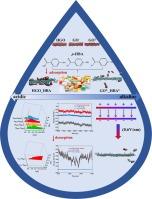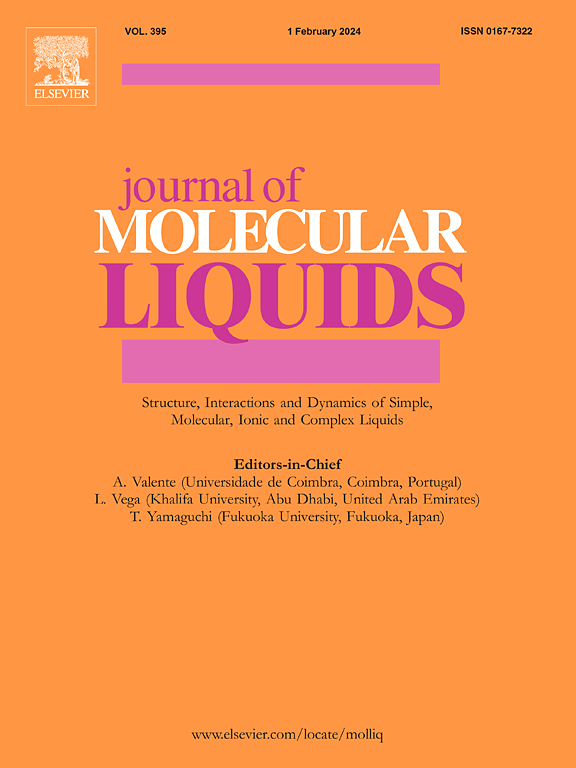The adsorption of p-hydroxybenzoic acid on graphene oxide under different pH and in-situ desorption in direct current electric field
IF 5.3
2区 化学
Q2 CHEMISTRY, PHYSICAL
引用次数: 0
Abstract
The development and ongoing optimization of measures to reduce and eliminate p-hydroxybenzoic acid (p-HBA) in industrial wastewater are significant due to its potential carcinogenic effect and bio-recalcitrant. Graphene oxide (GO) is an ideal adsorbent for removing aromatic acids and achieving adsorbent recovery and resource conservation. In this study, the adsorption properties of p-HBA onto GO at different pH values and the regeneration mechanism of adsorbent under varying electric field intensities were analyzed using molecular dynamics (MD) simulation. The simulation results demonstrate that GO exhibits preferable adsorption capabilities for p-HBA at low pH, and van der Waals (vdW) interaction plays a leading role. However, the adsorption stability decreases at high pH (particularly pH > 9.3) with most p-HBA desorption from the GO surface. When an electric field of 1.0 V/nm is applied to the acidic system (HGO_HBA_HBA−), the total adsorption interaction energy between GO and p-HBA decreases but remains high (−1836.93 kJ/mol). When a 0.6 V/nm electric field is added to the alkaline system (GO2−_HBA2−), the vdW and electrostatic interaction energies are recorded as −35.34 kJ/mol and 3546.97 kJ/mol. The vdW interaction is weak, and electrostatic repulsion increases, facilitating the desorption of p-HBA from the GO surface. This work aims to share insights into the microscopic removal mechanism of p-HBA on the GO surface under different pH values and provide a theoretical perspective on the regeneration mechanism of GO.

不同 pH 值下对羟基苯甲酸在氧化石墨烯上的吸附以及直流电场下的原位解吸
由于对羟基苯甲酸(p-HBA)具有潜在的致癌作用和生物螯合作用,因此开发和不断优化减少和消除工业废水中对羟基苯甲酸(p-HBA)的措施意义重大。氧化石墨烯(GO)是去除芳香酸的理想吸附剂,可实现吸附剂回收和资源节约。本研究利用分子动力学(MD)模拟分析了不同 pH 值下对-HBA 在 GO 上的吸附特性以及不同电场强度下吸附剂的再生机理。模拟结果表明,在低 pH 值条件下,GO 对 p-HBA 具有较好的吸附能力,其中范德华(vdW)相互作用起了主导作用。然而,在 pH 值较高时(尤其是 pH 值为 9.3 时),吸附稳定性下降,大部分 p-HBA 会从 GO 表面解吸。当对酸性体系(HGO_HBA_HBA-)施加 1.0 V/nm 的电场时,GO 和 p-HBA 之间的总吸附相互作用能降低,但仍然很高(-1836.93 kJ/mol)。当在碱性体系(GO2-_HBA2-)中加入 0.6 V/nm 的电场时,vdW 和静电相互作用能分别为 -35.34 kJ/mol 和 3546.97 kJ/mol。vdW 作用较弱,而静电斥力增加,从而促进了对-HBA 从 GO 表面的解吸。这项工作旨在分享不同 pH 值条件下 p-HBA 在 GO 表面微观脱附机理的见解,并为 GO 的再生机理提供一个理论视角。
本文章由计算机程序翻译,如有差异,请以英文原文为准。
求助全文
约1分钟内获得全文
求助全文
来源期刊

Journal of Molecular Liquids
化学-物理:原子、分子和化学物理
CiteScore
10.30
自引率
16.70%
发文量
2597
审稿时长
78 days
期刊介绍:
The journal includes papers in the following areas:
– Simple organic liquids and mixtures
– Ionic liquids
– Surfactant solutions (including micelles and vesicles) and liquid interfaces
– Colloidal solutions and nanoparticles
– Thermotropic and lyotropic liquid crystals
– Ferrofluids
– Water, aqueous solutions and other hydrogen-bonded liquids
– Lubricants, polymer solutions and melts
– Molten metals and salts
– Phase transitions and critical phenomena in liquids and confined fluids
– Self assembly in complex liquids.– Biomolecules in solution
The emphasis is on the molecular (or microscopic) understanding of particular liquids or liquid systems, especially concerning structure, dynamics and intermolecular forces. The experimental techniques used may include:
– Conventional spectroscopy (mid-IR and far-IR, Raman, NMR, etc.)
– Non-linear optics and time resolved spectroscopy (psec, fsec, asec, ISRS, etc.)
– Light scattering (Rayleigh, Brillouin, PCS, etc.)
– Dielectric relaxation
– X-ray and neutron scattering and diffraction.
Experimental studies, computer simulations (MD or MC) and analytical theory will be considered for publication; papers just reporting experimental results that do not contribute to the understanding of the fundamentals of molecular and ionic liquids will not be accepted. Only papers of a non-routine nature and advancing the field will be considered for publication.
 求助内容:
求助内容: 应助结果提醒方式:
应助结果提醒方式:


